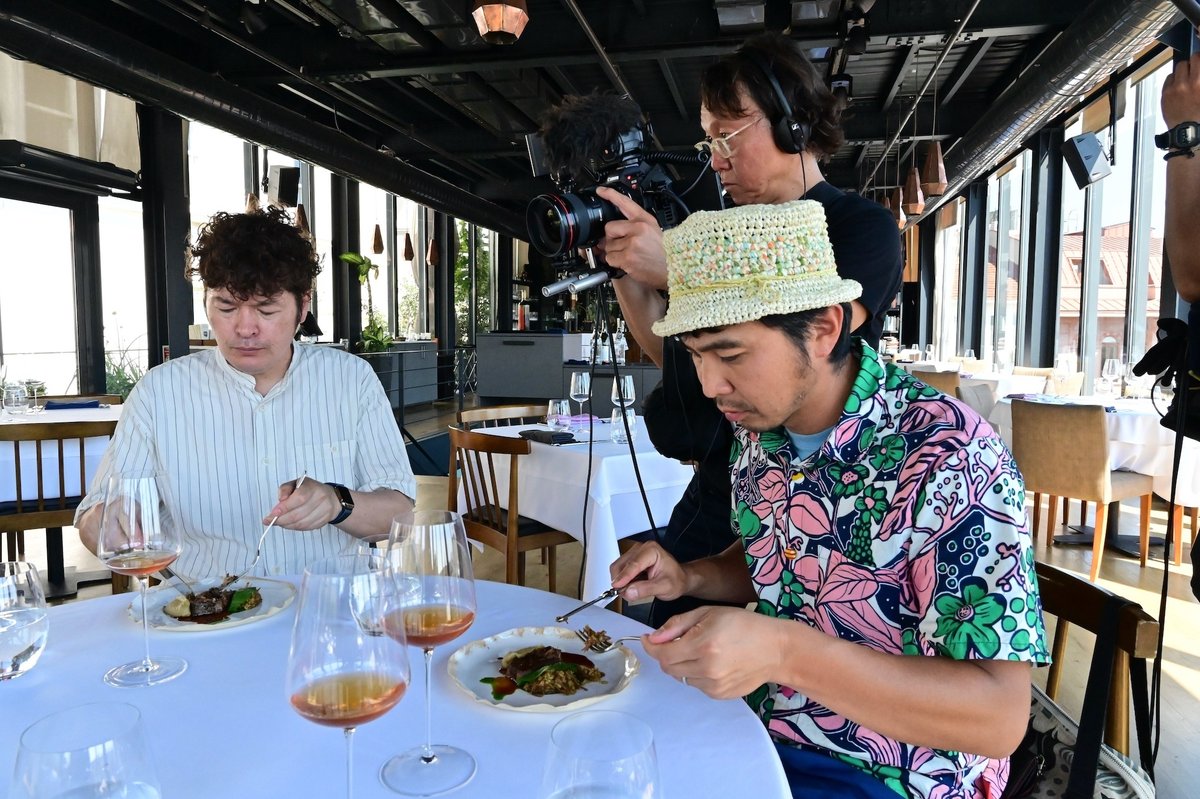
ハーブズメンのトルコ食い倒れ旅番外編1Neolokal
サラームの11冊目の著作『マージナル・フーディー・ツアー』が2023年12月に発売となります。その第6章「トルコ・ザ・ハーブズメンと食い倒れ」には、元々、第一章「トルコ・エーゲ海料理」と一部内容が重複する記事が存在していました。本書では割愛しましたが、こちらで投稿します。本の発売記念のおまけとしてお楽しみください。

2022年6月14日火曜。ザ・ハーブズメンのトルコ食い倒れ旅も四日目。僕の友人の人気シェフ、マクスット・アスカルのお店「Neolokal(ネオローカル)」を再訪した。2019年夏にこの店を初めて訪れた際の記事は『マージナル・フーディー・ツアー』の第一章に掲載したので、ぜひお読みいただきたい。
Neolokal再訪
ネオローカルはトルコ南東部出身のマクスットが、イスタンブル近郊の提携農家の農作物やローカルな食材を用いて、地域に根ざした伝統料理を現代的なスタイルで表現し、トルコ産のナチュラルワインとともにサーブすることで、新世代のトルコ料理を代表する人気実力店となった。インターネット上のレストランランク付けサイト「The World's 50 Best Restaurants.com」の2023年度にはなんと世界第63位に選ばれている。
これまで伝統料理やストリートフード、オスマン宮廷料理など、トルコ料理における過去の遺産を味わってきたザ・ハーブズメンが今回味わうのはトルコ料理の
未来型だ。

ネオローカルはガラタ塔近くの僕たちの宿から徒歩10分。カラキョイ埠頭へ向かう急な坂を下り、19世紀末に建てられた官公庁ビル街の一角にある元銀行の建物を改装した文化施設「SALT Galata」の最上階にある。屋上の広いテラスや全面ガラス張りの店内からは、カラキョイ埠頭や金角湾、旧市街が見渡せる。これまで僕は二回、夕食時に訪れ、料理とともに夜景を楽しんだが、今回はテレビ撮影クルーが付いてくるため、初めてお昼時に訪れた。

オーナーシェフのマクスットに会うのは半年ぶりだった。2021年末にトルコ南東部のグルメの街、ガジアンテップを訪れた際に、帰りのイスタンブルでお店に立ち寄り二年半ぶりに再会し、その翌日には彼行きつけの黒海料理の安食堂ロカンタにも案内してもらっていた。いつもはちきれんばかりの笑顔をふりまく彼にお土産の日本酒を渡し、ザ・ハーブズメンの3人を紹介した。
「初めてのトルコ旅行で、ネオローカルを選んでくれて、ありがとうございます。今日はテイスティングメニューとおすすめのナチュラルワインを楽しんでもらいます」

脱構築メイハネ体験
まず最初は「メイハネ(居酒屋)の体験」をテーマにした2種類のアミューズ。左はメイハネに入ると、誰もが最初に頼む3品=「ラク、メロン、白チーズ」を再構築したもの。日干ししてドライフルーツにしたメロンをアニスのお酒ラクに漬け込み、上には白チーズのホイップクリーム。さらに中東の「ゆかり」に当たるハーブのスマックと、黒くなるまでローストした赤唐辛子粉のイソットをふりかけてある。一口でパクっと口に入れると、メロンの甘さ、白チーズの塩っぱさ、ラクのアルコールとアニス臭、まさにメイハネの風景が脳内に広がるのだ!
右のロール状のアミューズは中に焼きパプリカと胡桃のペーストであるムハンマラが詰めてある。こちらもトルコのメイハネの定番のメゼの再構築版だ。こんなに小さなアミューズだけでメイハネのエッセンスが伝わってくる。

続いて一本目のエーゲ海のオレンジワインとともに運ばれてきた冷たいメゼ。ホモス、トルコ語では「フムス」を二種類。四角く盛り付けられたのは「冬のフムス」。トルコ料理らしい、練胡麻が少なめのフムスを冬らしい食材=保存食品を使って仕上げている。カラフルな色はビーツやブルーベリー、唐辛子やミントなどを乾燥させ、粉にしたもの。それぞれに色だけでなく、微妙な風味を加えてくれる。右上の小さな黄色はウズラの半熟卵。冬の小さな太陽を表現しているそうだ。

そしてもう一つの丸皿は「春のフムス」。フムスは唐辛子のピクルスの漬け汁でホイップクリーム状態に延ばしてあり、春らしい野菜、そら豆やアスパラガス、ディルやエディブルフラワーなどで飾られている。周りにはオレンジと柚子のソース、ハーブオイルを回しかけてある。冬のフムスと比べると軽やかでスパイシー。まさにアナトリアの春を想起させる味。美味い!

マルマラ海の幸も脱構築
次のメゼはスズキの葡萄の葉巻き。酢でマリネしたスズキのフィレを包丁でたたき、海苔のようにカリっと乾燥させた葡萄の葉に丸めてある。上に乗るピンク色の小さなキューブは塩漬けのカツオ、更にオレンジ色のカラスミ、海苔の天ぷら、魚の出汁のクリームが添えてある。これも一口でパクっと口に入れると、酸っぱさ、苦さ、カリカリ、シットリ、さまざまな味とテクスチャーが一度に楽しめる。
「ここが今までで一番美味しいですね!」と水野仁輔さん。カレー研究家として知られる水野さんは意外にもフレンチや現代的なフュージョン料理が好きで、その点、僕と気が合うのだ。

続いては魚料理。ブラックバスのミキュイ、スープ仕立て。ブラックバスの大きな切身を高温のオーブンでサッと火を通し、泡状にしたスープに沈めている。スープはブラックバスのアラの魚出汁と、白インゲン豆や玉ねぎの野菜出汁が合わせてある。更に青ネギのハーブオイルを回しかけ、コリアンダー、クミン、フェンネルの3つのホールスパイスを散らしてある。白身魚の柔らかさにシャキシャキの野菜の豆、ふわっとした泡。そして三種類のホールスパイスをプチっと噛むごとにそれぞれ口の中に広がる風景が変わる。


ラム肉はハーブズメン全員が黙り込む美味さ!
口直しにイラクサのシャーベットを鋏み、2つ目の地元ナチュラルワインを開けていると、肉のメインディッシュ、ラムの首肉のオーブン焼きが運ばれてきた。食べやすいモモ肉やヒレ肉でなく、あえてスジが多い首肉を低温オーブンで14時間も焼いているそう。左の青菜の下には未熟成の青麦のフリーカとバーミセリを炊いたピラフ。右側の黄土色のペーストは、黒海地方の料理であるムフラマを、本来のとうもろこし粉と牛のチーズの代わりに、フリーカの粉とトゥリュム・ペイニリ(羊の皮にくるんで、土の中に埋めて発酵させた山羊や羊のチーズ)でエーゲ海風に再現したもの。上にはラムのグレービーソースと緑のハーブオイル。これはアナトリア内陸の伝統料理、タンドール・クズ(ラムのタンドール焼き)の再構築版だ。

小さな立方体にカットされた肉塊は量こそ控えめだが、ナイフで切り分けてソースとともに口に入れると、首肉ならではの複雑なテクスチャーがホロホロでトロトロ。そこにラムの旨味、エッセンスがグッと凝縮されていた。これは美味い!美味すぎる! これならラムバサダーのシャンカール・ノグチさんも満足では? ふと顔を上げると、いつもは食べながら話が止まらないザ・ハーブズメンの3人が完全に無言になっていた。それでいて顔つきは真剣そのもの。マクスットが作るトルコの過去、現在、未来を見据えた料理に完全にノックアウトされてしまったのだ。テレビカメラは回り続けているのに、誰一人気の利いた事を言えなくなってしまったのだった……。


Turkey:The Herbsmen vol.1 Neolokal
Salam's 11th book, "The Marginal Foodie Tour", will be released in December 2023. Chapter 6, "Turkey:The Herbsmen Eat'em all! " originally contained articles that overlapped in part with Chapter 1, "Turkish and Aegean Cuisine.'' I omitted them in the book, but I will post them here. Please enjoy this as a bonus to celebrate the release of the book.
On Tuesday, June 14, 2022, the fourth day of The Herbsmen's culinary journey in Turkey, we revisited the restaurant 'Neolokal,' run by my friend and popular chef, Maksut Askar. I had first visited Neolokal in the summer of 2019, an experience I documented in the first chapter of "Marginal Foodie Tour," which I highly recommend reading.

Neolokal, led by Maksut, a native of Southeastern Turkey, has become a popular and prestigious establishment, representing the new generation of Turkish cuisine. It uses local ingredients and produce from affiliated farms near Istanbul, creatively presenting traditional dishes with a modern twist, paired with Turkish natural wines. In 2023, Neolokal impressively ranked 63rd in the online restaurant ranking site "The World's 50 Best Restaurants.com."
This visit marked our exploration of the future of Turkish cuisine, having previously savored traditional dishes, street food, and Ottoman court cuisine. Neolokal is located on the top floor of 'SALT Galata,' a cultural facility in a former bank building near the Galata Tower. The restaurant offers stunning views of the Karakoy Pier, Golden Horn, and the old city from its spacious terrace and glass-enclosed interior. This was my first lunchtime visit to Neolokal, usually frequented for dinner to enjoy the cuisine and night views. I met with owner-chef Maksut after half a year. At the end of 2021, during a visit to Gaziantep, a gourmet city in Southeastern Turkey, I revisited Neolokal and then dined at his favorite Black Sea cuisine Lokanta.

Maksut, always beaming with a broad smile, welcomed The Herbsmen - myself and two others, and thanked us for choosing Neolokal for our first trip to Turkey. He promised a delightful experience with their tasting menu and recommended natural wines.
The first dishes were two types of amuse-bouche themed around the "Meyhane (tavern) experience." The left dish reconstructed the first three items typically ordered in a Meyhane - 'Raki, Melon, and White Cheese.' The melon, dried into a fruit leather, was soaked in the anise-flavored spirit Raki, topped with white cheese whipped cream, sprinkled with smacked herbs (Middle Eastern 'Yukari') and Isot, a red pepper powder roasted until black. This one-bite dish unfolded the entire Meyhane scene in the mind. The right dish, a roll-shaped amuse-bouche, contained roasted red pepper and walnut paste, known as Muhammara, another reinterpretation of a classic Meyhane mezze.
This was followed by two types of hummus, served with the first bottle of Aegean orange wine. The square-plated 'Winter Hummus' was a Turkish-style hummus with less tahini, garnished with dried and powdered beets, blueberries, peppers, and mint, adding subtle flavors and vibrant colors. The small yellow on the top right represented a quail's semi-cooked egg, symbolizing a tiny sun of winter. The round-plated 'Spring Hummus' was lighter and spicier, whipped with pickle juice from chili peppers and adorned with spring vegetables like fava beans, asparagus, dill, and edible flowers, drizzled with orange and yuzu sauce and herb oil.
The next mezze was a grape leaf-wrapped Sea Bass. The marinated sea bass fillet was minced, dried to a crisp like nori, and wrapped in grape leaves. Topped with pink salt-cured bonito cubes, orange-colored bottarga, nori tempura, and a fish stock cream, it was a symphony of flavors and textures in one bite.
The fish dish was Black Bass Mi-cuit, a soup-based preparation. The large bass fillet, quickly heated in a hot oven, was submerged in a frothy soup made from bass bones and vegetable stock of white beans and onions. Green onion herb oil was drizzled over, and whole spices of coriander, cumin, and fennel were scattered. The softness of the fish, crunchy vegetables, airy foam, and the burst of flavors from each spice made for a dynamic culinary experience.
After a palate-cleansing nettle sherbet, we opened the second bottle of local natural wine, leading to the main meat dish: oven-roasted lamb neck. Opting for the tougher, sinew-rich neck meat, it was slow-cooked for 14 hours. The greenery on the left concealed an undercooked green wheat Freekeh and vermicelli pilaf, while the right-side ochre paste was a reinterpretation of the Black Sea's Muhlama dish, made with Freekeh flour and Tulum Peyniri (a fermented cheese wrapped in goat or sheep skin), representing the Aegean style. Topped with lamb gravy and green herb oil, it was reminiscent of the traditional Anatolian inland dish, Tandir Kuzu (Tandoor-cooked lamb).
The small cubes of lamb meat were modest in quantity but rich in flavor and texture, offering a concentrated essence of lamb. The Herbsmen, usually chatty while eating, were utterly silenced by Maksut's interpretation of Turkey's past, present, and future cuisines. Overwhelmed by the dishes, we found ourselves unable to articulate our thoughts, even with the TV cameras rolling.
この記事が気に入ったらサポートをしてみませんか?
